16 Best Sales Methodologies That Drive Results
Casey O'Connor
Did you know that nearly 80% of top-performing teams are guided by formal sales processes? Sales teams that follow a clear, structured outline through the sales process are the most successful ones.
There are generally two main ways to add high-level structure to your sales organization: formalizing the sales process and implementing specific sales methodologies.
A sales methodology is a set of rules, principles, and philosophies that sales reps can follow to guide their approach and decision-making process throughout the sales cycle. Sales organizations implement sales methodologies because they help sellers translate goals into actionable steps and frameworks.
In this article, we’ll go over everything you need to know about sales methodologies, including what they are, the 16 most effective options for your team to consider, and how to implement the ones you choose to adopt.
Here’s what we’ll cover:
- What Is a Sales Methodology?
- 16 Best Sales Methodologies
- How to Choose the Right Sales Methodology
- How to Implement a New Sales Methodology
What Is a Sales Methodology?
A sales methodology is a high-level sales framework that outlines how sellers should approach buyers and the overall sales process.
Most sales methodologies are created based on buyer psychology. They help sellers understand the thought processes, desires, fears, and motivations of buyers so that they can more effectively prospect, qualify, and close.
Sales methodologies help maintain a seamless operating process between each stage of the sales process. Implementing formalized sales methodologies clarifies the sales process for everyone involved and helps keep the process running smoothly.
Think of a sales methodology as the “North Star” for a seller throughout the sales process. It gives sales reps strategies and thought processes to reference as they encounter opportunities and challenges. When teams adhere to specific sales methodologies, it helps promote consistency across the sales team.
16 Best Sales Methodologies
When it comes to sales methodologies, the truth is that the “best” ones are completely unique to each team and company; their needs, goals, and resources will all dictate which methodology represents the best fit.
With that in mind, here’s our comprehensive list of the most popular and successful sales methodologies.
1. Conceptual Selling
The Conceptual Selling sales methodology was developed by Robert Miller and Stephen Heiman. It was designed under the premise that buyers don’t buy for the sake of a specific product or service. Instead, buyers purchase the concept of the solution represented by the offer. 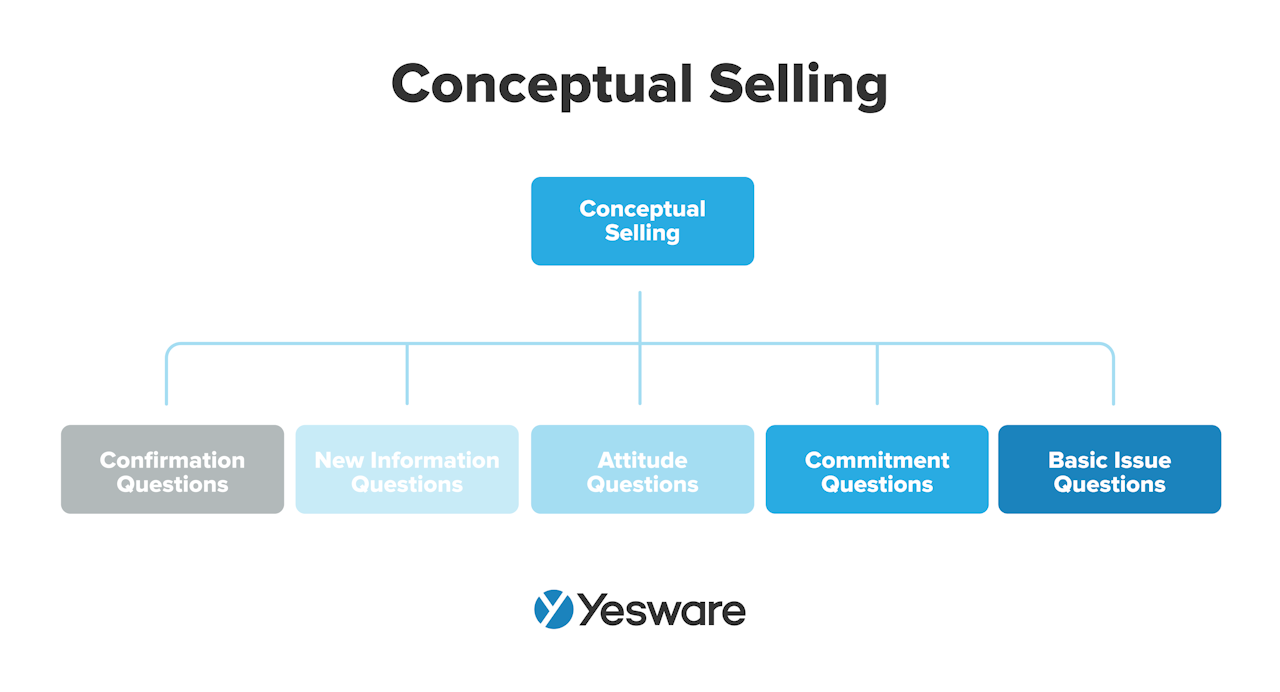 Conceptual Selling relies on sellers to be astute listeners who ask the right questions that illustrate the buyer’s ideal outcome. Sales reps are trained to ask the following kinds of questions:
Conceptual Selling relies on sellers to be astute listeners who ask the right questions that illustrate the buyer’s ideal outcome. Sales reps are trained to ask the following kinds of questions:
- Confirmation Questions: Confirmation questions are designed to reaffirm information and get prospects and sellers on the same page with a mutual understanding of the problem and desired outcome.
- New Information Questions: These are clarifying questions that are meant to clear up any misunderstandings or fill in information gaps.
- Attitude Questions: Sellers ask attitude questions to learn more about the prospect as an individual — on both a professional and a personal level — and to better understand their stake in the process.
- Commitment Questions: Commitment questions are designed to understand just how invested the prospect and their organization is in finding a solution.
- Basic Issue Questions: Sellers ask questions about “basic issues” to pre-emptively resolve any potential problems or objections.
In Conceptual Selling, the sale should be a win-win solution for both prospect and seller. The seller needs to listen carefully to ensure that their offer represents a great solution for the prospect. It’s a good sales methodology for complicated sales processes and high-value contracts with several decision-makers.
2. N.E.A.T.
The N.E.A.T. sales methodology was developed by Sales Hacker and the Harris Consulting Group. It was created as an updated option to other traditional qualification methods like BANT and ANUM.
The N.E.A.T. method focuses on four core areas of questioning: Need, Economic Impact, Access to Authority, and Timeline. 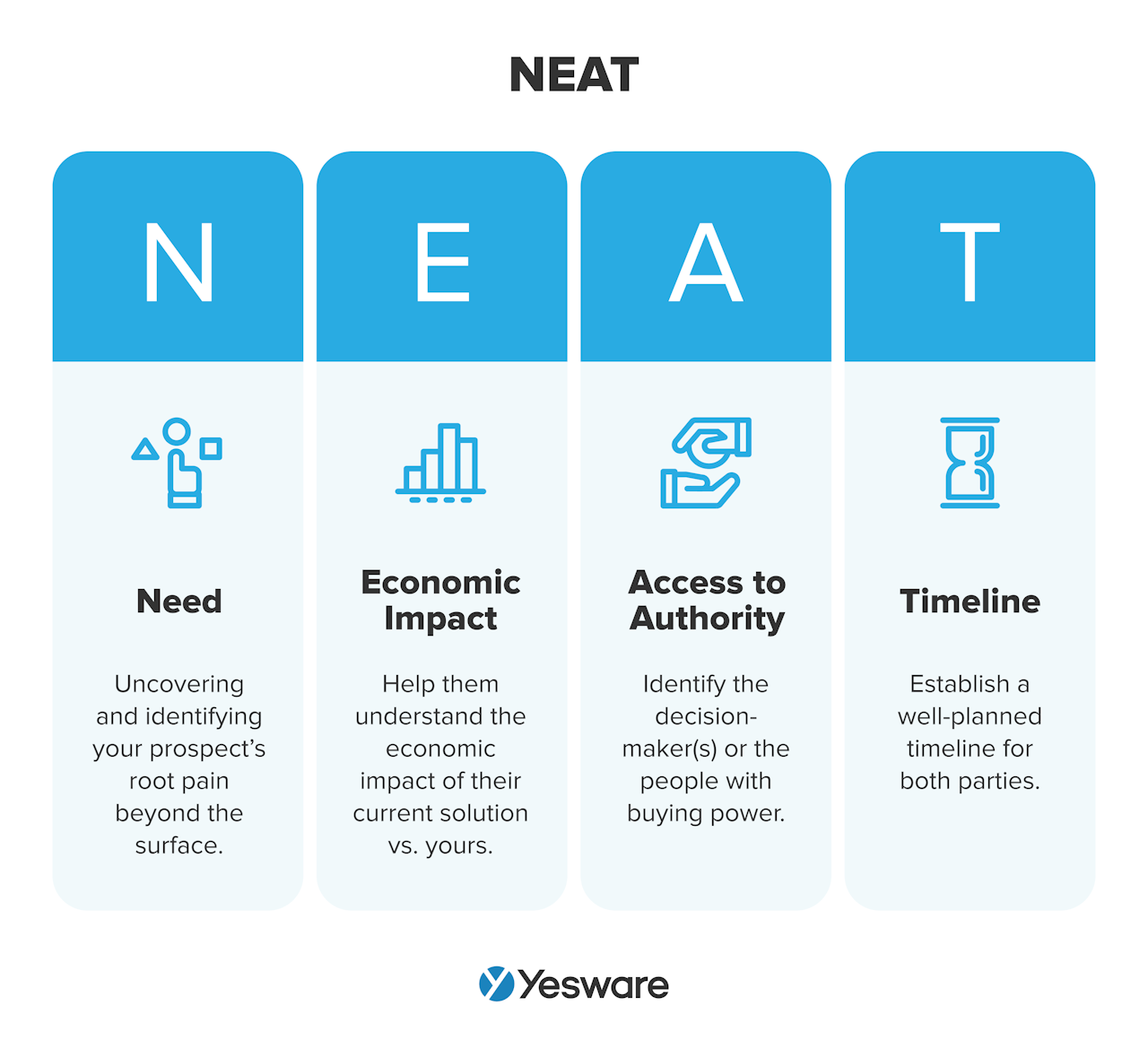 N.E.A.T. is most effective when used during the qualification stage.
N.E.A.T. is most effective when used during the qualification stage.
3. The Challenger
Made popular by their book of the same name, The Challenger Sales Method was developed by Matthew Dixon and Brent Adamson. They argue that salespeople fall into one of five seller personality types.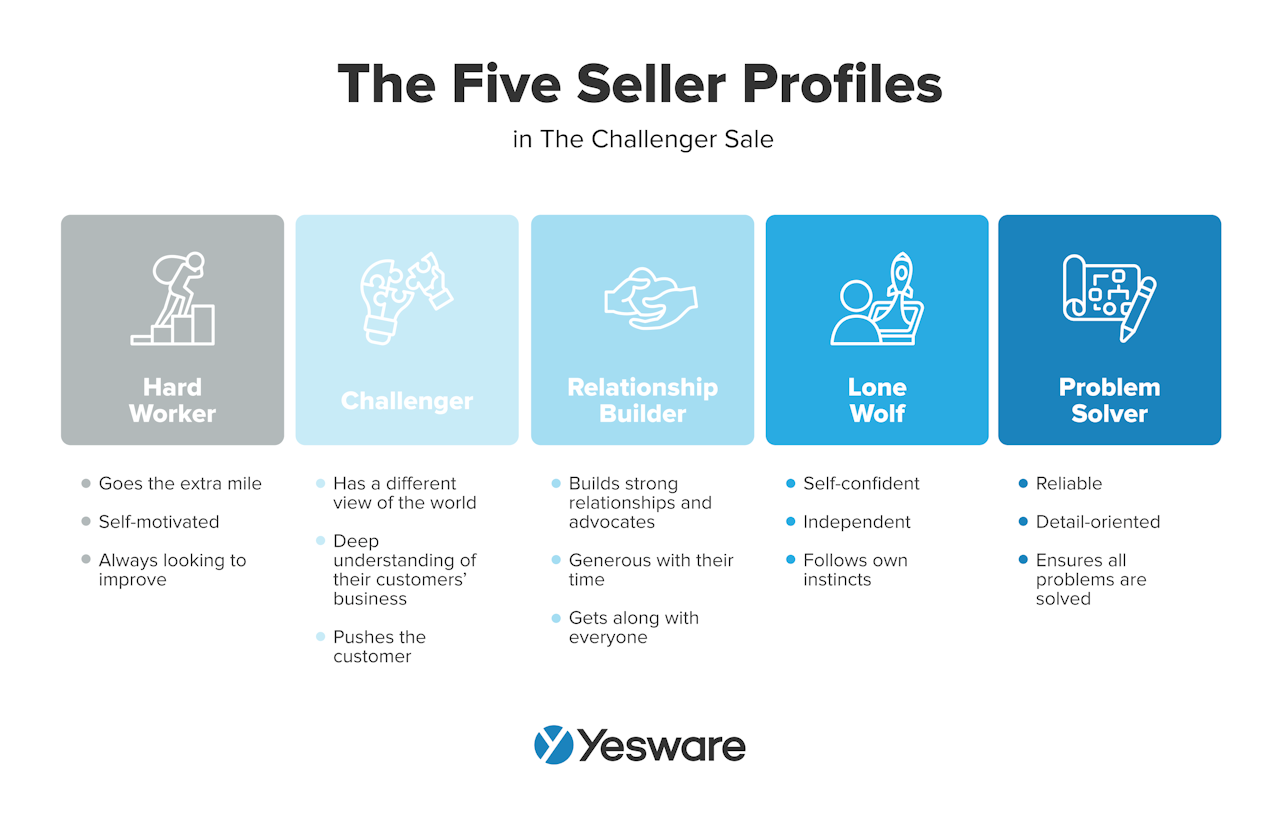 According to Dixon and Adamson, more top-performing salespeople adopt a Challenger style than any other seller style — about 40% of top-performing sellers approach with a Challenger mindset, with the next most popular being the Lone Wolf (25%).
According to Dixon and Adamson, more top-performing salespeople adopt a Challenger style than any other seller style — about 40% of top-performing sellers approach with a Challenger mindset, with the next most popular being the Lone Wolf (25%).
The Challenger seller is known for their three-step approach to the sales process: teach, tailor, and take control. This sales rep knows how to deliver valuable, relevant information that’s new to the buyer, tailor their offer so that the solution meets the prospect’s needs, and take control of the close.
The Challenger sales methodology is very effective in complex B2B sales cycles.
4. SPIN Selling
The SPIN Selling sales methodology was developed by Neil Rackham. It’s designed to uncover the root of a prospect’s problem very quickly by asking the right targeted questions. 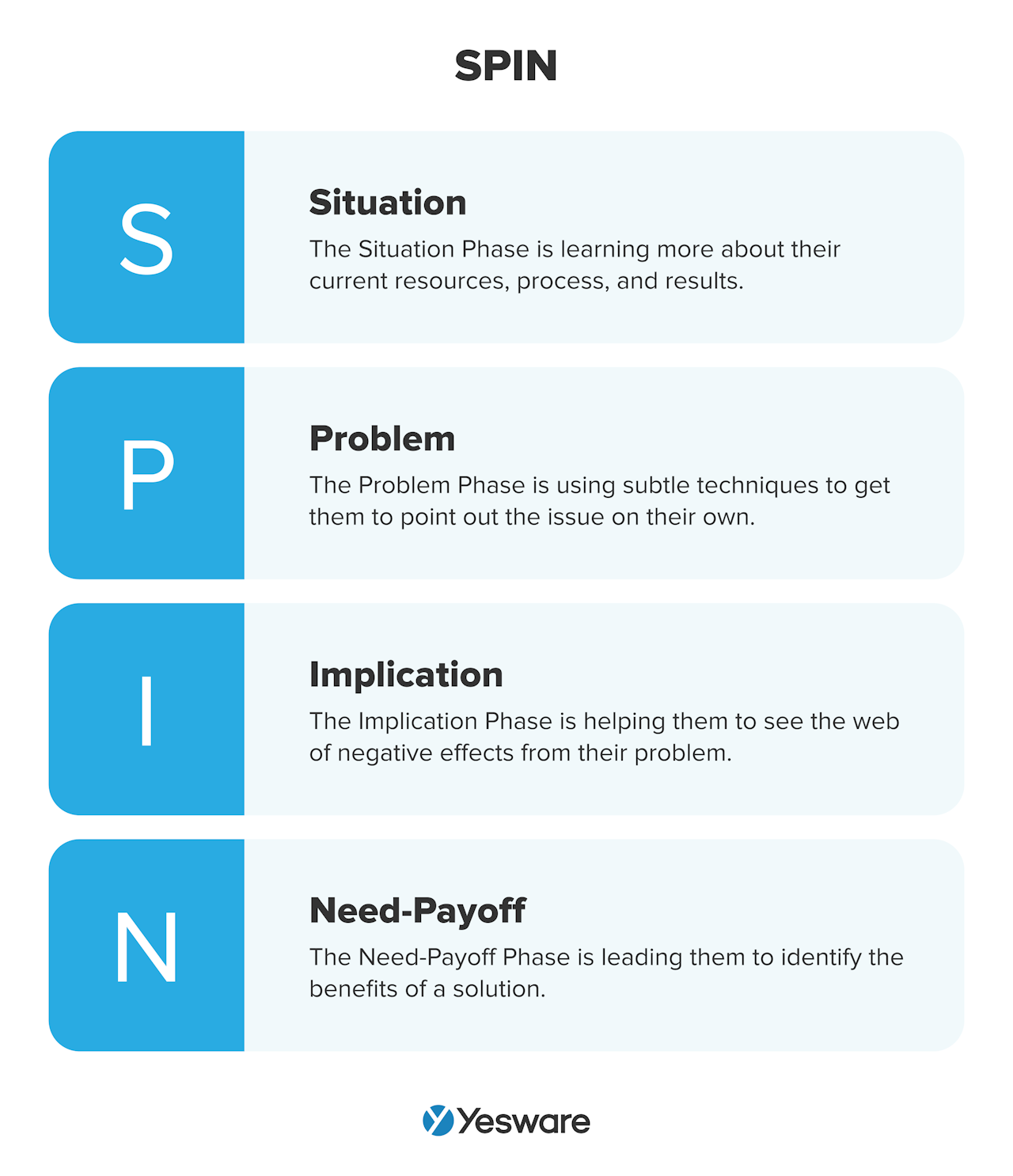 The acronym SPIN stands for the words that describe how sales reps should approach their questions:
The acronym SPIN stands for the words that describe how sales reps should approach their questions:
- Situation: Sales reps should start by asking questions about the prospect’s current situation.
- Problem: Once the basics are established, more poignant questions can be introduced — ones that get to the core of the prospect’s pain points.
- Implication: After the prospect outlines their challenges, it’s time for the sales rep to up the ante. Discuss in detail the potential consequences of not adopting the proposed solution.
- Need-Payoff: By the end of the discovery phase, sales reps should also paint a picture of what the prospect’s life could be like if their problems were solved.
The SPIN selling methodology is designed to guide buyers through the discovery process in a way that allows them to feel in control. Sales reps’ questions should guide — not force or pressure — prospects into understanding and articulating their own problem, and ultimately arrive at the conclusion that the offer presented is the best solution.
It’s worth noting that there are some who believe the SPIN Selling sales methodology is becoming outdated. With the huge increase of information available to prospects through the buying process, there are some who believe prospects who lack an understanding of their problem are becoming few and far between.
Still, though, the SPIN Selling method is worth exploring for sellers who work with prospects who have complex pain points. This methodology is also really effective for building rapport and trust with buyers.
5. Target Account Selling
The main idea behind Target Account Selling is that picking the right prospects with whom to engage at the very beginning is the most important part of the sales process.
In fact, this sales methodology encourages sellers to continue prioritizing all throughout the process. At each stage, the seller needs to ask themselves: Is this opportunity still worth pursuing?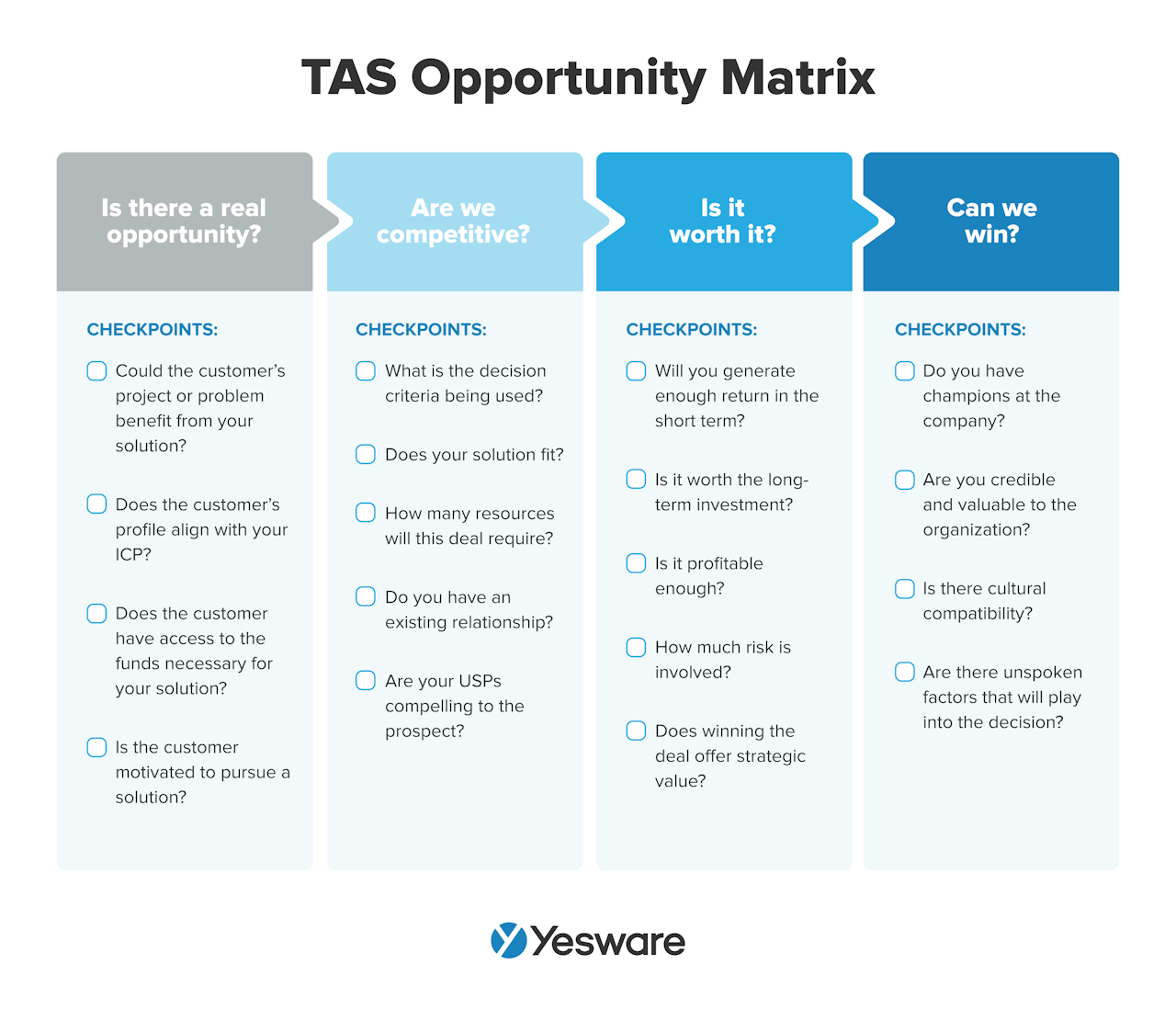 Target Account Selling relies on sales automation technology to help identify the buyer behavior that’s most likely to indicate a qualified lead. Target Account Selling is about prioritizing the quality of leads over the quantity.
Target Account Selling relies on sales automation technology to help identify the buyer behavior that’s most likely to indicate a qualified lead. Target Account Selling is about prioritizing the quality of leads over the quantity.
6. Sandler Sales Method
The Sandler Sales Method has been around for quite some time and is a fantastic choice for sales teams who are new to implementing formalized sales methodologies.
The Sandler Sales Method helps sellers position themselves as trusted advisors in the sales process, and encourages salespeople to view the buyer as an equal party. Both parties should be equally invested in and assured that the offer is the best-fit solution; if not, the method encourages parties to part ways so as to not waste anyone’s time.
There are three main phases in the Sandler Sales Method: (1) Build a relationship; (2) Qualify the opportunity; (3) Close the deal. Each of those stages is further broken down into a formalized process.
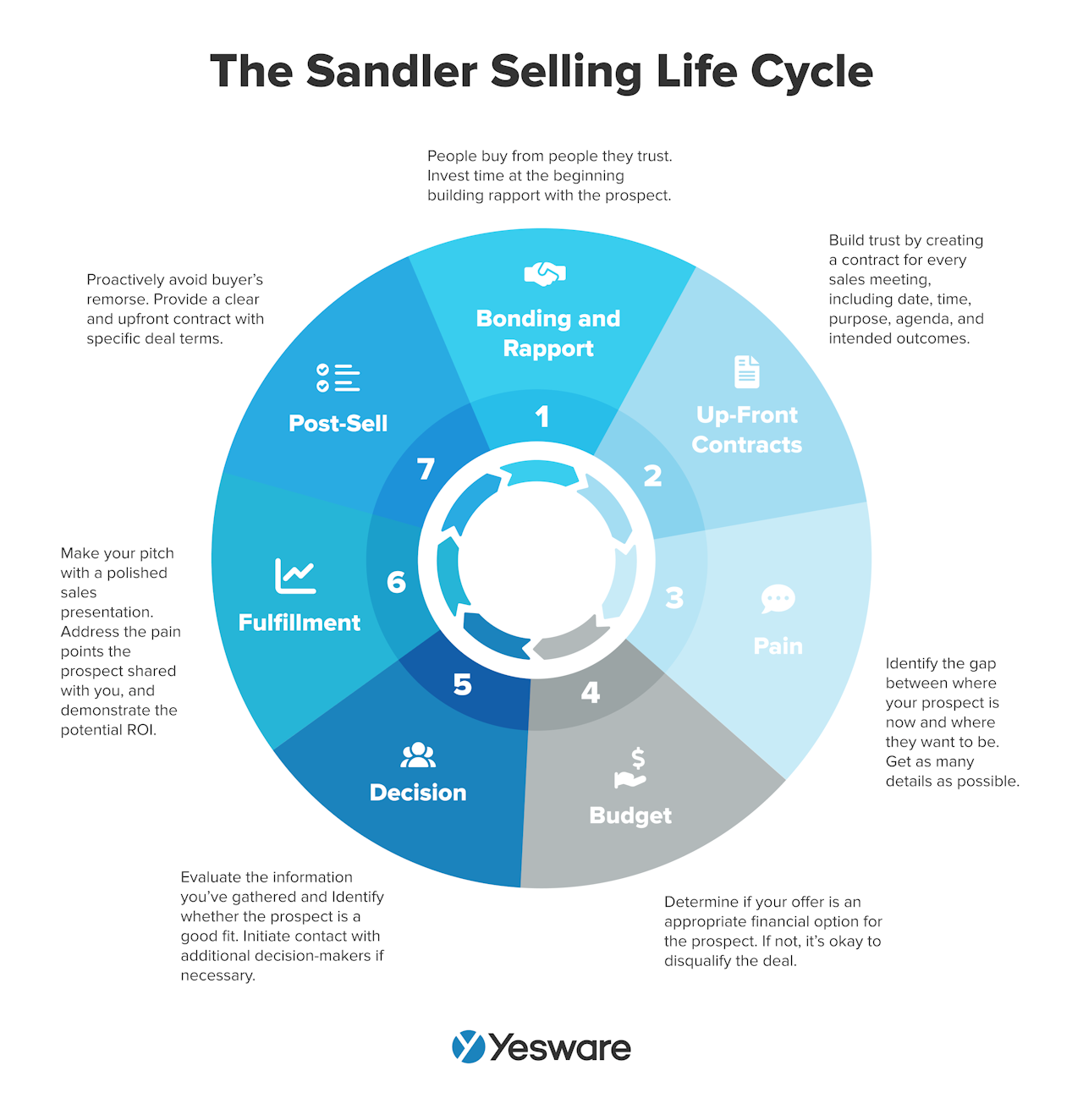 One of the main tenets of the Sandler Sales Method is that the seller should work to raise and overcome objections throughout the process. The idea here isn’t to forcefully overcome every objection; instead, the seller should aim to understand the possible objections as early as possible so that no time is wasted on poor-fit leads.
One of the main tenets of the Sandler Sales Method is that the seller should work to raise and overcome objections throughout the process. The idea here isn’t to forcefully overcome every objection; instead, the seller should aim to understand the possible objections as early as possible so that no time is wasted on poor-fit leads.
This respect for a buyer’s time is one of the reasons that the Sandler Sales Method is so effective at building strong customer relationships.
7. MEDDIC
MEDDIC is one of the more popular lead qualification frameworks, and many sellers will already be familiar with its basic methodology.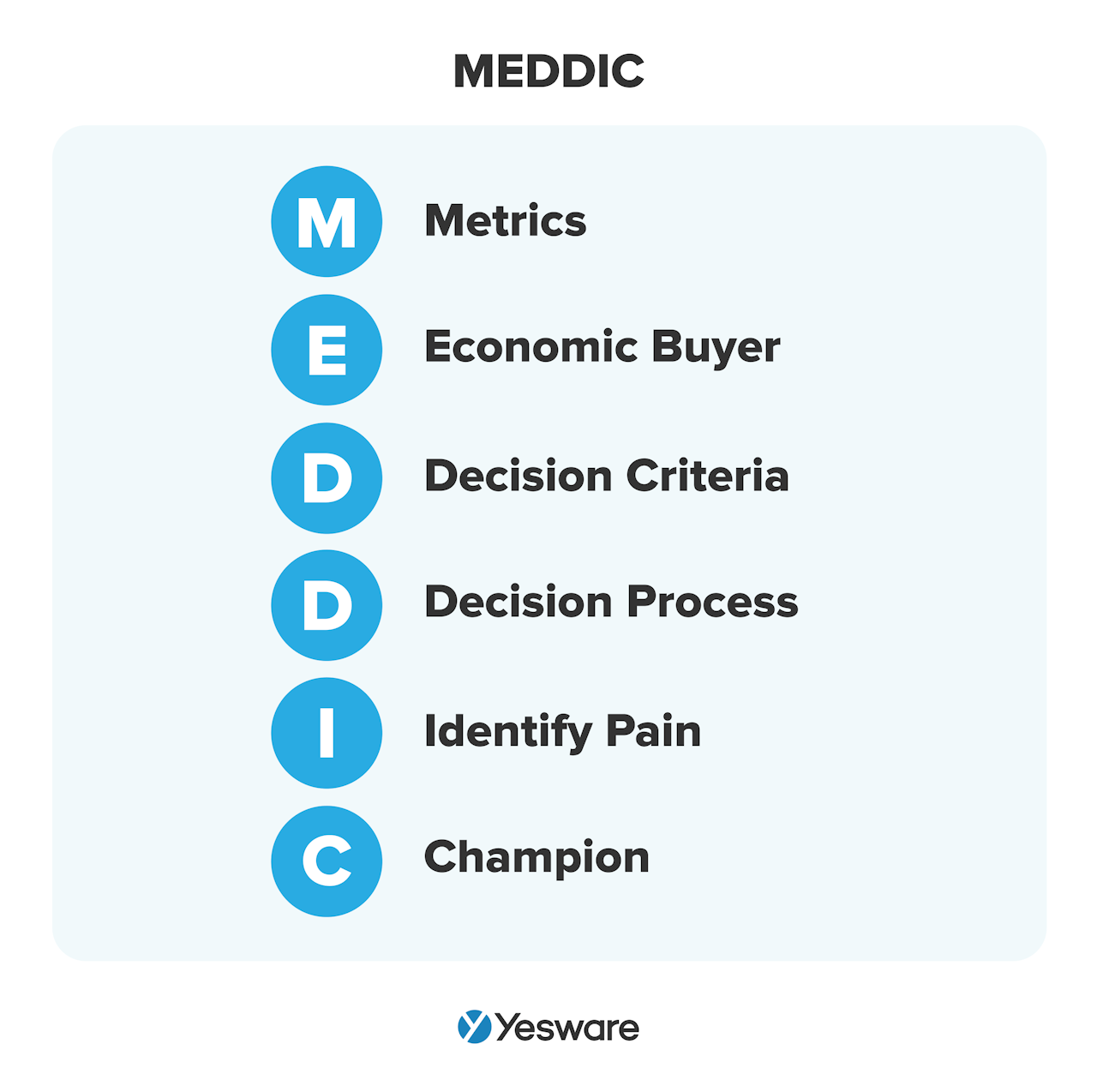 The acronym represents its guiding principles:
The acronym represents its guiding principles:
- (M)etrics: In the beginning of the process, the seller should work to learn about the quantifiable metrics that the buyer is hoping to improve. They need to uncover more about the specific economic impact of the buying decision.
- (E)conomic Buyer: Once the end goal is clear, the seller then needs to understand who controls the purse strings, and whether or not they’re yet involved in the buying conversation. If the prospect that the seller is engaging with isn’t authorized to spend the money, the seller needs to find and connect with someone who is.
- (D)ecision Criteria: Next, the sales rep should learn more details about the formal decision criteria the prospect will use to evaluate your offer against your competitors’.
- (D)ecision Process: Hand in hand with the decision criteria is the decision process: How will the prospect choose an offer? What timeline are they on? What additional information or education do they need to reach a consensus?
- (I)dentify Pain: Once the purchasing criteria and process are clear, sales reps can begin to dig into the buyer’s pain points. In particular, salespeople should emphasize the potential financial consequences of leaving the problem unsolved.
- (C)hampion: Finally, sales reps should get some insight into which members of the prospect’s organization are their champions. The end user is often not the same person as the decision maker, so it’s important for reps to understand which people will be most impacted by your solution, and work to connect with them so that they can sell behind the scenes on your behalf.
The MEDDIC framework is very useful for enterprise sales or otherwise long or complicated sales processes. It’s a tightly-controlled framework that generates very solid lead qualification results, which in turn creates higher close rates.
8. Solution Selling
Solution Selling is another option that’s relatively easy to implement. It focuses on sales reps really understanding each prospect’s unique buying needs and process, with the understanding that today’s buyer is much more informed than in generations past. 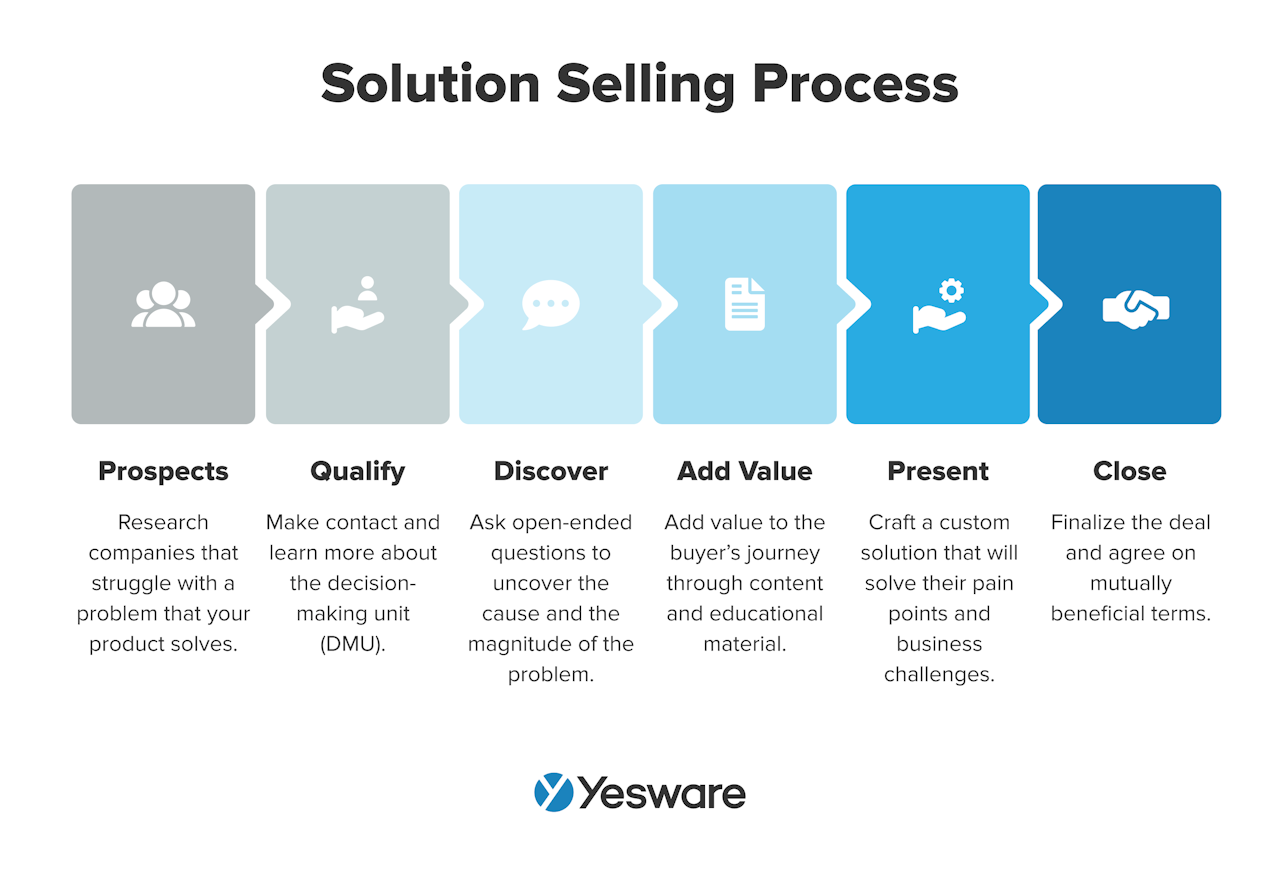 Solution Selling gives sales reps the chance to meet buyers exactly where they are in the process, and position their offer as a perfect fit for their needs. It emphasizes the idea that sales reps can use what they know about a buyer’s specific pain points to tailor a custom solution or mix of products that will meet their needs.
Solution Selling gives sales reps the chance to meet buyers exactly where they are in the process, and position their offer as a perfect fit for their needs. It emphasizes the idea that sales reps can use what they know about a buyer’s specific pain points to tailor a custom solution or mix of products that will meet their needs.
Tip: Grab more data-backed strategies and trends for selling in 2022.
 Sales Engagement Data Trends from 3+ Million Sales ActivitiesLooking at millions of tracked email activity over the past few years, this ebook is filled with our top studies and findings to help sales teams accelerate results.
Sales Engagement Data Trends from 3+ Million Sales ActivitiesLooking at millions of tracked email activity over the past few years, this ebook is filled with our top studies and findings to help sales teams accelerate results.
9. SNAP
The SNAP selling method was developed by Jill Konrath. It was created under the assumption that buyers today have very little time or bandwidth for decision-making and aims to make the sales process easy and efficient.
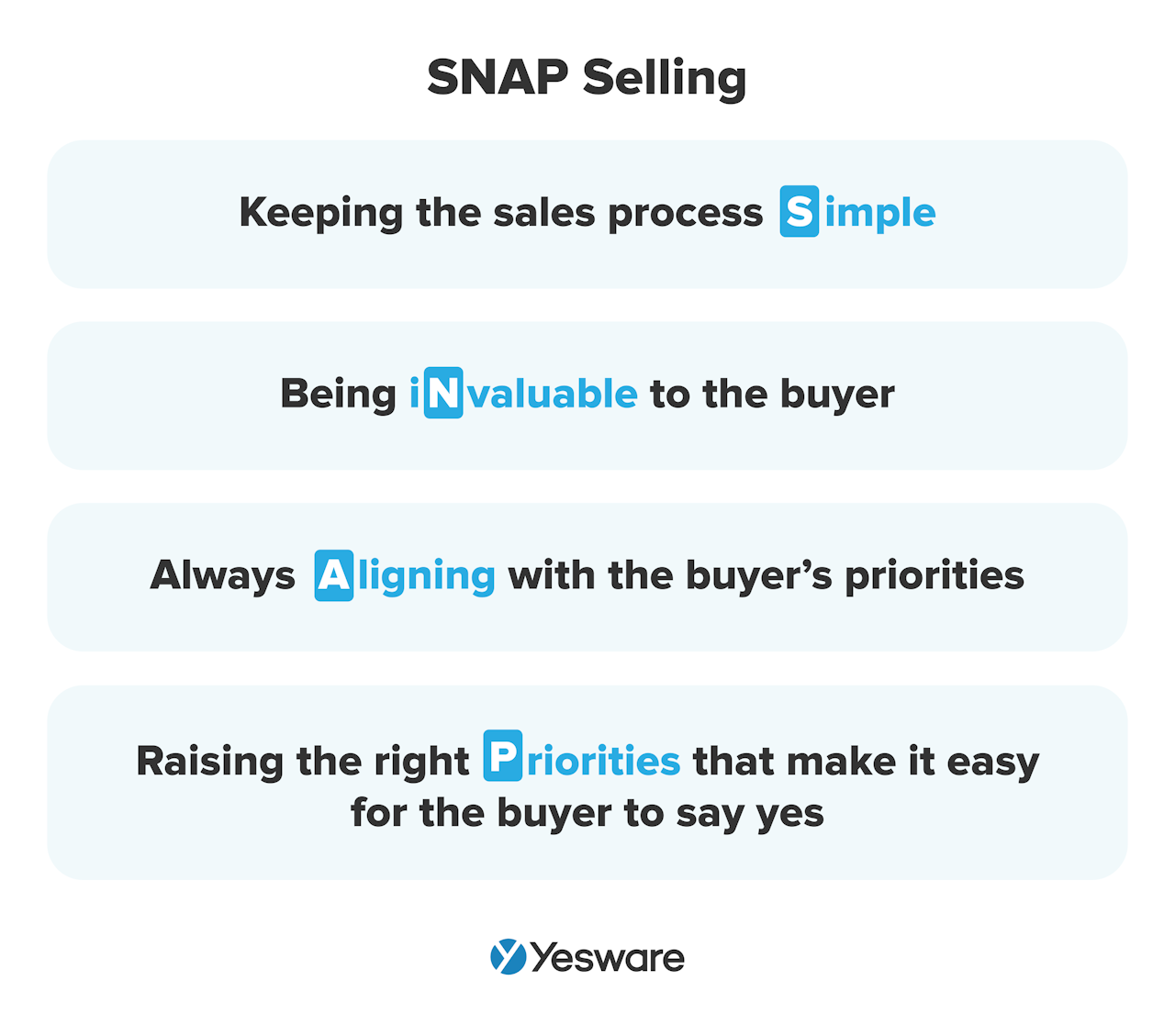 SNAP stands for:
SNAP stands for:
- Keeping the sales process (S)imple
- Being i(N)valuable to the buyer
- Always (A)ligning with the buyer’s priorities
- Raising the right (P)riorities that make it easy for the buyer to say yes
The SNAP selling methodology assumes that buyers move through three major decision points in the sales process: choosing to give a seller access to their process; choosing to move away from the status quo; choosing to change resources in favor of a new solution.
To approach these buyer decision points, SNAP teaches sellers to become trusted advisors to prospects. This method encourages salespeople to connect with buyers through sharing of valuable content.
10. Inbound Selling
The Inbound Selling methodology has gained a ton of popularity in recent years. Like many of the other sales methodologies in this article, Inbound Selling acknowledges that buyers have gained a lot of control in the buying process as a result of more and more information being available online. Inbound Selling gives sellers the chance to meet prospects where they are with relevant content and education.
Inbound Selling has four main stages: Identify, Connect, Explore, and Advise.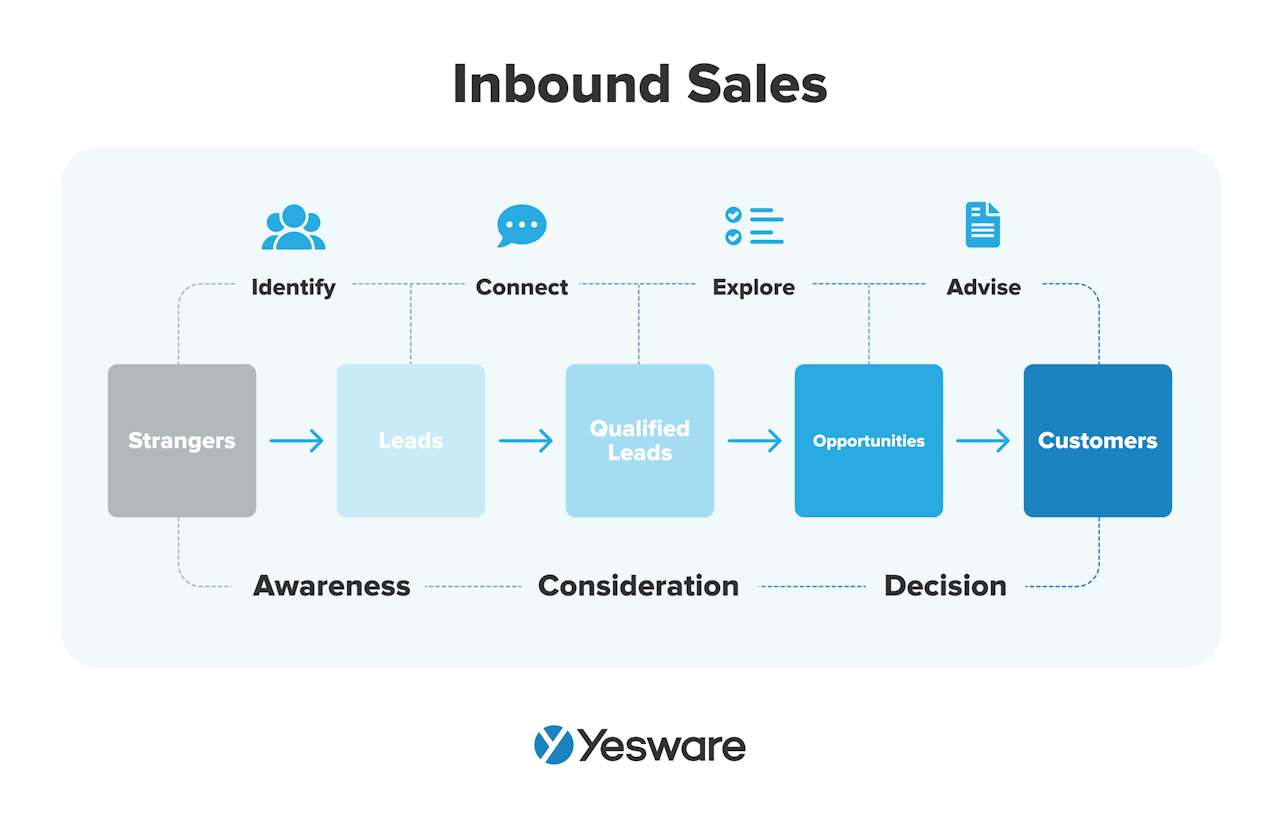 The Identify stage is all about identifying and prioritizing the most engaged buyers. Sellers should target the prospects who are actively evaluating their offer. They can gain insight into a prospect’s inclination with tech tools that give data on page views, social media profile visits, click-through rates (CTRs), email opens, and more.
The Identify stage is all about identifying and prioritizing the most engaged buyers. Sellers should target the prospects who are actively evaluating their offer. They can gain insight into a prospect’s inclination with tech tools that give data on page views, social media profile visits, click-through rates (CTRs), email opens, and more.
In the Connect stage, sellers should offer buyers personalized messaging and content through things like blog posts, social media outreach, and email drip campaigns. The content should resonate with buyers thanks to the insight sellers gained through the Identify stage.
The Explore stage is focused on building rapport with buyers and digging deeper into their challenges and goals.
Sales reps attempt to close in the Advise stage, during which they present personalized sales pitches that speak directly to individual buyer needs.
Sales and marketing need to be closely aligned for the Inbound Selling methodology to succeed. It also relies on heavy input from sales technology that can provide powerful reporting and analytics on buyer behavior and desires.
11. Command of the Sale
The Command of the Sale methodology relies on salespeople to be the most interesting person in the room.
Sales reps who use this sales methodology need to have exceptional product and buyer knowledge and need to know how to present the sale in a way that conveys urgency and intensity. The line between a Command of the Sale approach and a pushy one can be hard to walk, so most sales reps will need sales training and coaching in this method.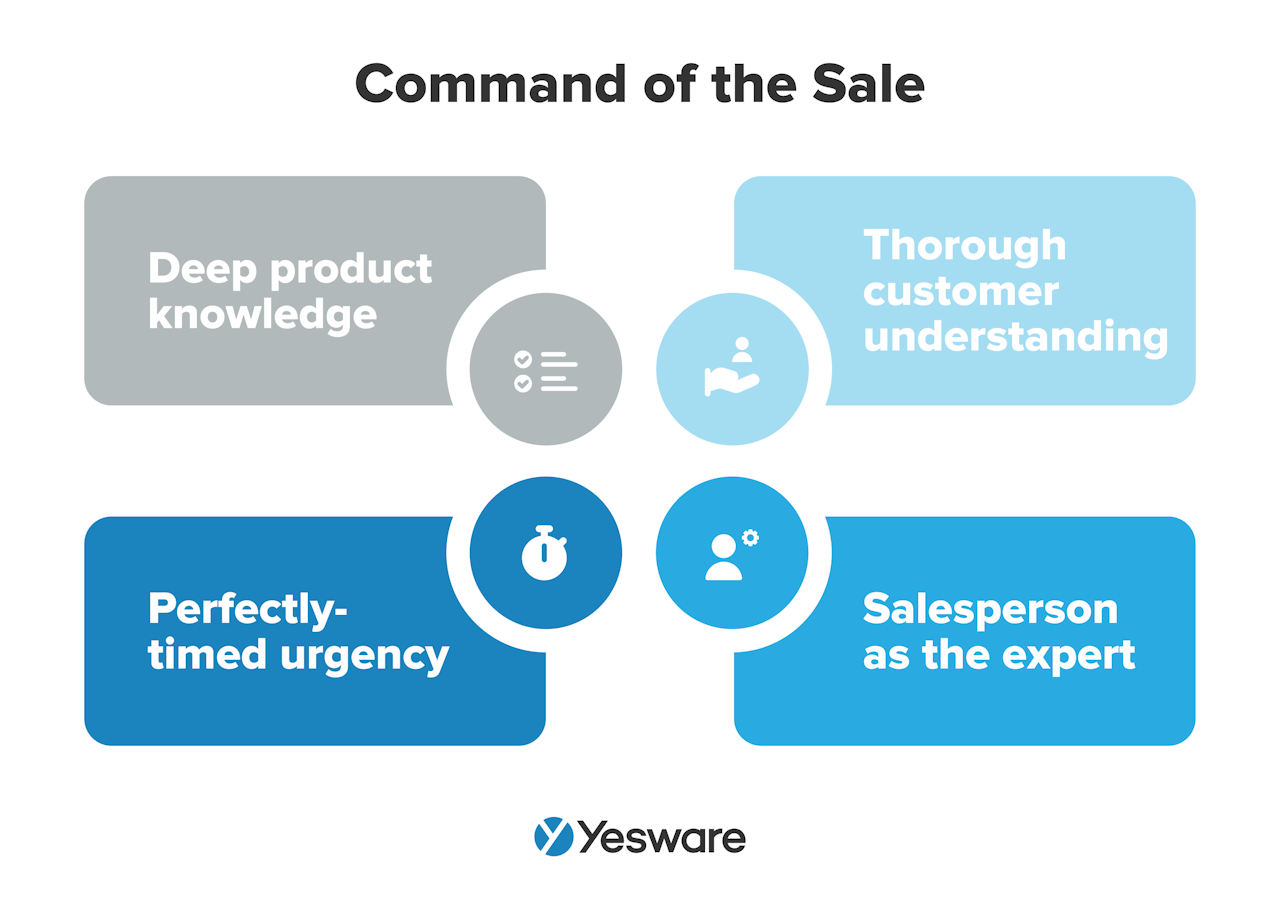 Command of the Sale requires that salespeople have a deep, intimate knowledge of both their own solution and the prospect’s pains, hopes, and goals. They need to understand how each unique prospect measures success for their organization, as well as what makes their offer so much better than anything else on the market.
Command of the Sale requires that salespeople have a deep, intimate knowledge of both their own solution and the prospect’s pains, hopes, and goals. They need to understand how each unique prospect measures success for their organization, as well as what makes their offer so much better than anything else on the market.
12. Gap Selling
The Gap Selling approach to sales puts prospects first. It advocates for sellers to focus on the problem instead of the product — and, specifically, how the solution can bridge the gap between where a prospect currently operates and where they wish to be.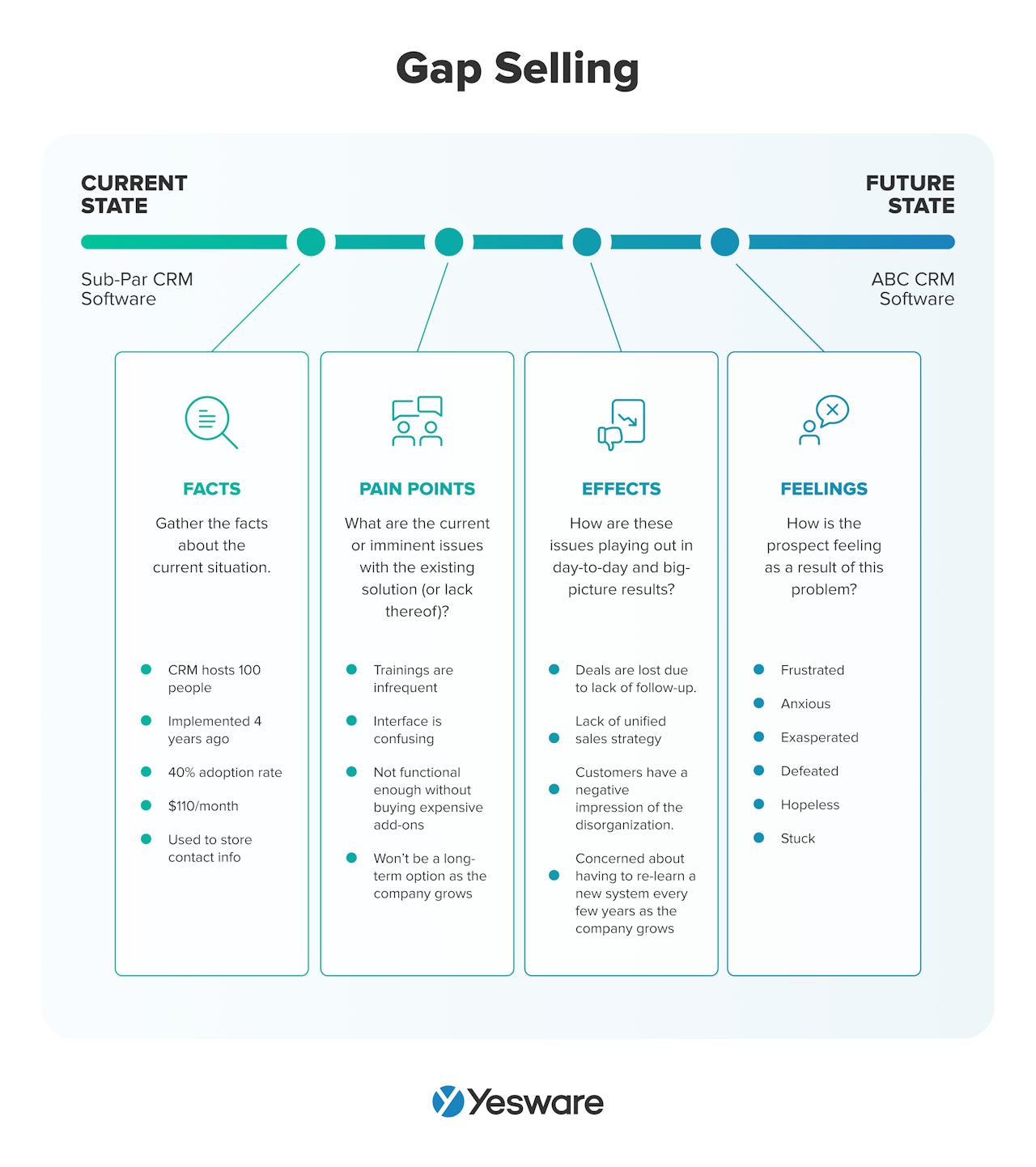 The most important thing that sales reps need to understand about the Gap Selling sales methodology is that it’s most successful when reps focus on understanding everything they can about a prospect and their business: their challenges, pain points, fears, goals, and dreams.
The most important thing that sales reps need to understand about the Gap Selling sales methodology is that it’s most successful when reps focus on understanding everything they can about a prospect and their business: their challenges, pain points, fears, goals, and dreams.
The more they understand these hidden buyer motivators, the better they can position their product as the best (or only) solution for reaching their ideal state.
13. Consultative Selling
The Consultative Selling method was written about by Mark Hanan, but finds its roots in Solution Selling. It has six main stages, all of which revolve around the seller asking targeted and insight-provoking questions to the buyer.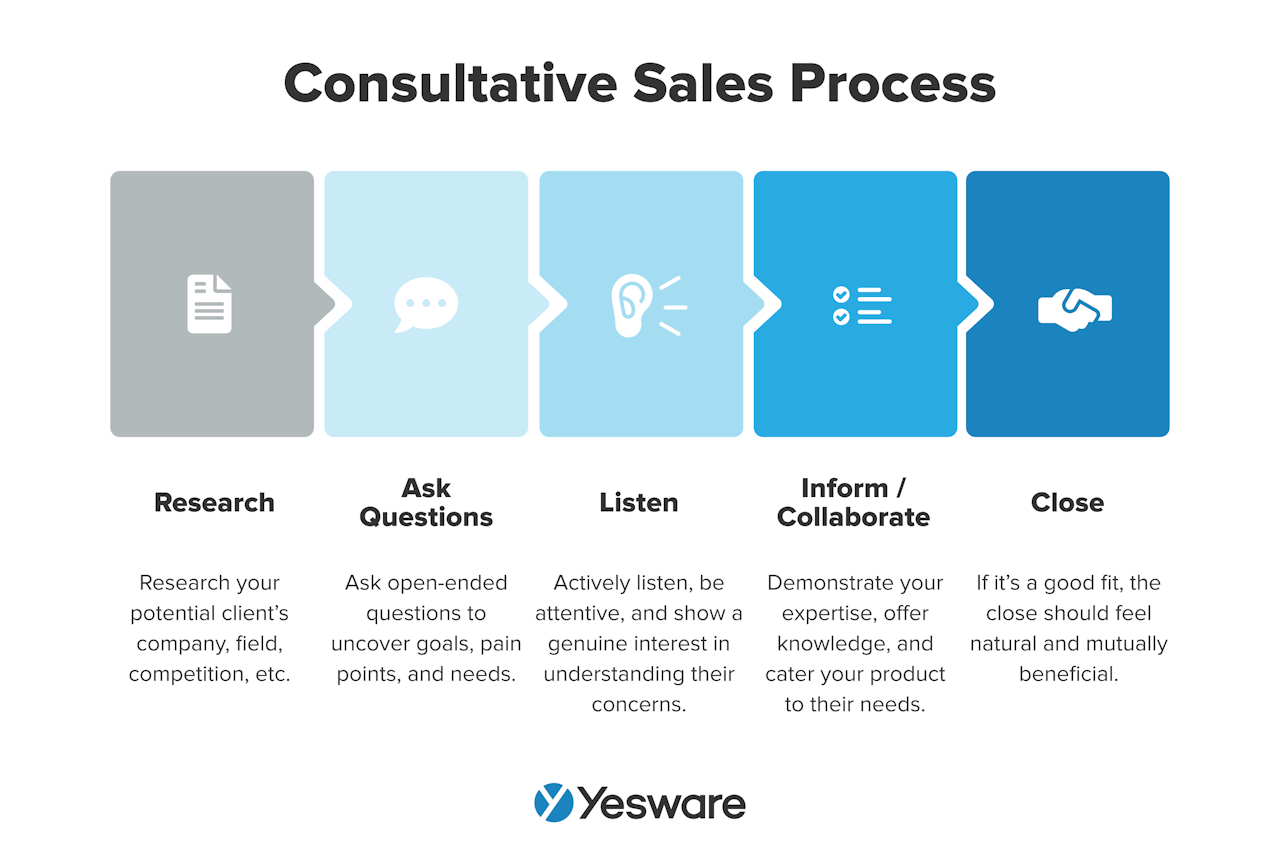 The goal of Consultative Selling is to get the buyer to want to make a purchase because they trust the seller. Sellers, therefore, need to be able to position themselves as a person of expertise, one with extensive industry knowledge and the reputation to back it up.
The goal of Consultative Selling is to get the buyer to want to make a purchase because they trust the seller. Sellers, therefore, need to be able to position themselves as a person of expertise, one with extensive industry knowledge and the reputation to back it up.
Consultative Selling works really well for businesses that rely on word of mouth.
14. Customer-Centric Selling (CCS)
Customer-Centric Selling (CCS) is described in a book by the same name written by John Holland, Michael Bosworth, and Frank Visgatis.
Like its name suggests, CCS is all about the customer, all the time. This methodology encourages salespeople to be flexible and accommodate as much as they can when it comes to buyer priorities, needs, schedules, and convenience. Sales reps should customize or adapt offers based on a buyer’s objectives and specific buying situations.
There are 8 main foundational principles of the CCS approach: 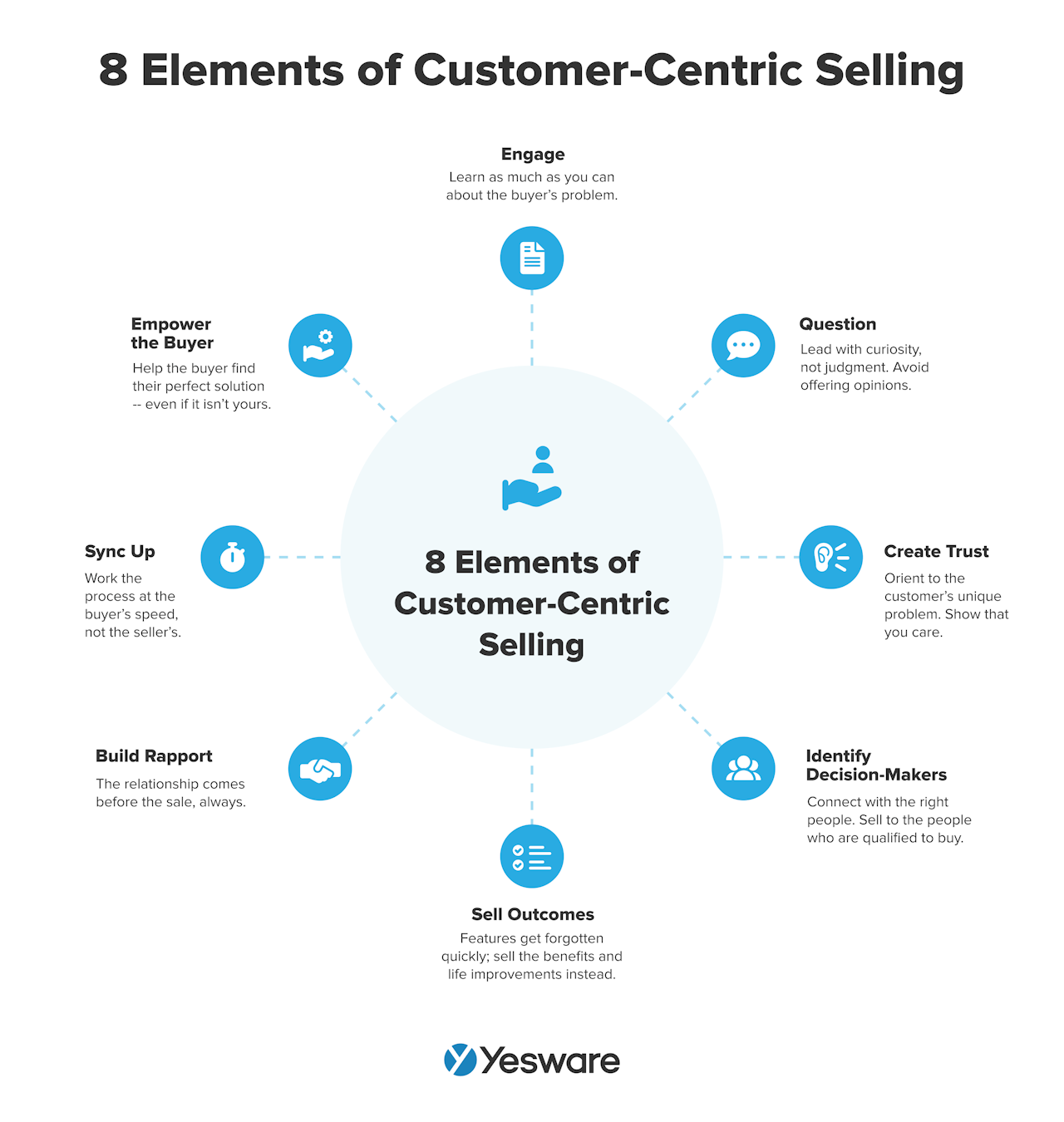 It’s important to note that sales reps using the CCS approach should feel free to walk away from the deal if it’s clear a solution can’t be formatted in a way that will benefit the buyer. It’s okay to adapt or tailor offers to specific buyer needs, but not at any cost. If the deal won’t be profitable to one or another party, it’s okay to disqualify the lead.
It’s important to note that sales reps using the CCS approach should feel free to walk away from the deal if it’s clear a solution can’t be formatted in a way that will benefit the buyer. It’s okay to adapt or tailor offers to specific buyer needs, but not at any cost. If the deal won’t be profitable to one or another party, it’s okay to disqualify the lead.
15. Value Selling
The Value Selling sales methodology aims to close more deals, more quickly by focusing on highly effective lead qualification.
It encourages sales managers and reps to dedicate their resources to determine which leads are most likely to improve your bottom line.
Sales reps using the Value Selling approach need to be able to ask the right questions of buyers to uncover their needs, and also to articulate the value of their offer in regard to the buyer’s priorities. 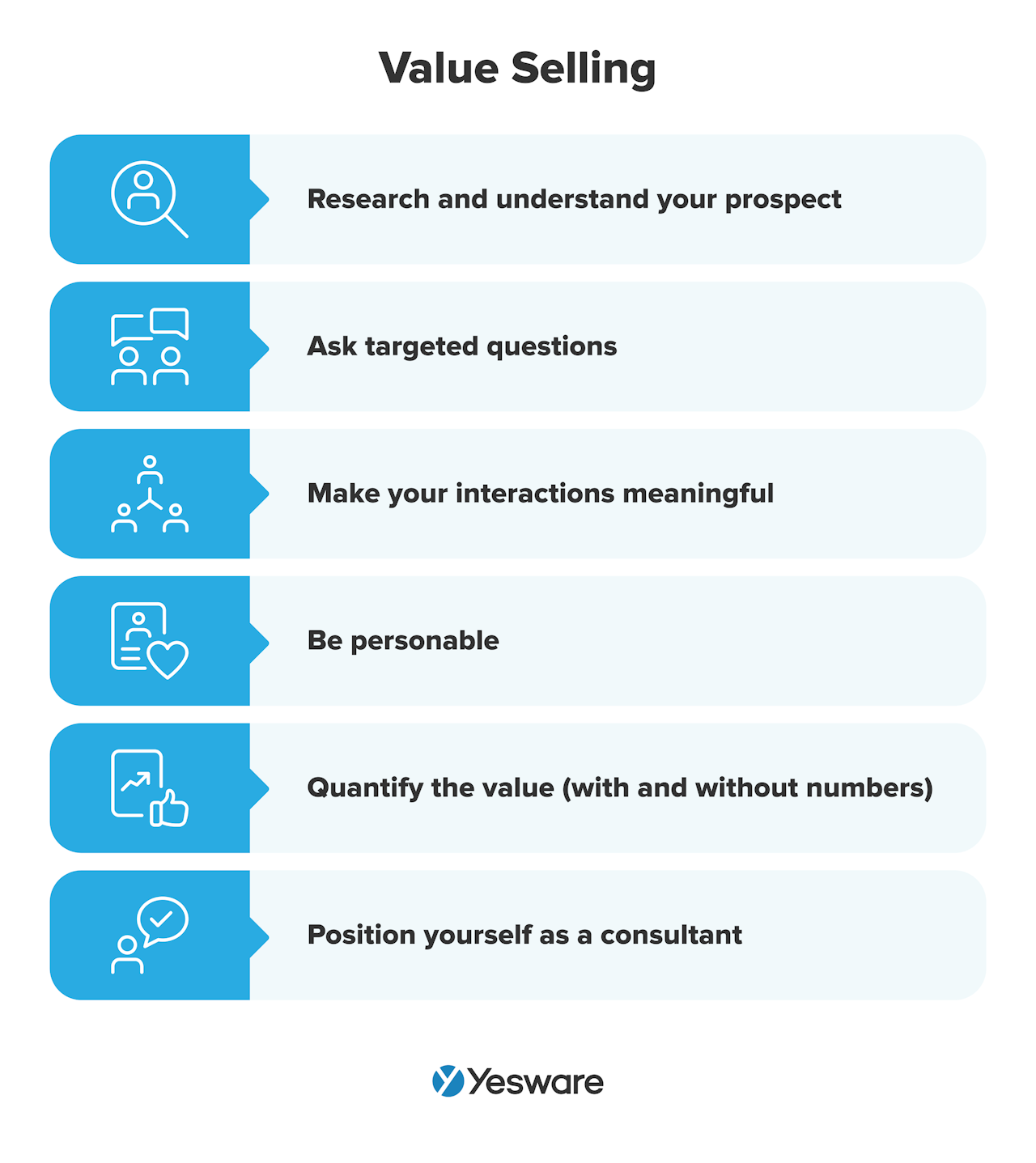 Sales reps using the Value Selling approach can add value with content like blog posts, whitepapers, and case studies. They should be friendly, trusted advisors in the sales process and should be flexible to the buyer’s needs.
Sales reps using the Value Selling approach can add value with content like blog posts, whitepapers, and case studies. They should be friendly, trusted advisors in the sales process and should be flexible to the buyer’s needs.
16. SaaS (Selling as a Science)
This acronym probably looks familiar, but it’s subtly different from the more widely-known “Software as a Service.”
When it comes to sales methodologies, SaaS stands for “Selling as a Science,” and was created by Jacco van der Kooj. Fortunately, the confusion stops there — Selling as a Science was designed to meet the needs of sellers who sell Software as a Service.
Van der Kooj argued when he created Selling as a Science that SaaS companies actually don’t start making real money until after the initial close. The traditional sales process, then, isn’t wholly applicable to SaaS sales cycles. Instead, the Selling as a Science approach prioritizes post-close stages like onboarding, user impact, and growing and scaling accounts.
It’s important to note that Selling as a Science isn’t necessarily meant to replace any of the pre-close sales methodologies; instead, it acts as a complement and a continuation of the more traditional sales funnels that focus on awareness, consideration, and action stages.
Tip: Looking to learn more? Check out our glossary of 100 common sales terms here.
How to Choose the Right Sales Methodology for Your Team
The ultimate goal of choosing and implementing a sales methodology (or several) is to empower sales teams to take charge of their own success by providing them with a playbook of proven approaches, tactics, and frameworks. Keep that at the top of your mind when you’re choosing the right sales methodology for your team.
Beyond that, the sales methodologies you choose should align with the strengths, needs, and goals of your product, your organization, your prospect, and your overall market.
Ultimately, the right sales methodology for each team is highly unique and will be determined by a number of factors — things like average deal size, sales cycle, and customer acquisition cost (CAC) all come into play when it comes time to choose your sales approach.
That being said, there are some general “categories” that describe how each market works that can help determine which methodologies could be a good fit.
Market Categories
- DIY/Self-Service: In a self-service sales model, buyers are able to research, educate themselves, and complete the entire sales cycle — including purchase — entirely by themselves. They do not require input from sales reps. These sales processes don’t typically require complicated sales methodologies.
- Transactional Selling: In transactional selling, prospects research and choose their own product, but usually ask for help from a sales rep in completing the final purchase. These buyers are usually efficient in their decision-making and don’t have a lot of time to spare in deliberating options with sales professionals. They will sacrifice cost or features for ease of purchase and use. These contracts are usually worth less than $1000 and the sales cycle is usually less than one month.
- Solution Selling: In a solution selling model, most customers have a firm grasp on the details of their problem. They are open to sellers who can speak directly to their pain points. Customers in this market are not shopping around based on price; they require or wish for specific features for which they are willing to pay.
- Consultative Selling: Customers in this market do not fully understand their own problems. They can see the effects of the problem but may have trouble articulating its roots or main components. The sales cycle in these scenarios takes anywhere from 6 to 18 months, and sellers spend much of that time educating their prospects. This model is usually found in sales of platform-esque solutions and requires input from several decision-makers.
- Provocative Selling: Provocative selling addresses a market in which prospects are not even fully aware that they have a problem, or will have one imminently. Sellers in this market need to be able to pre-emptively identify clients who might face the problem sometime soon, and provoke them to engage in finding a solution. Sales in this realm take anywhere from 3 to 9 months and require sellers to be extremely persuasive and innovative. The Challenger sales method works very well for this market.
Assessment
Knowing how your customers behave within the sales process will help you determine which sales methodologies to choose for your team.
If you sell a product that’s easy for a buyer to understand, or one that they’re already aware of, choose a sales methodology that makes it easy and fast for a buyer to agree to the deal. If, on the other hand, you sell a more complicated product, choose a method that helps the sales rep and the buyer come to a consensus about the root of the problem.
It’s also okay (and, in fact, beneficial) to use multiple sales methodologies throughout the sales process. Many teams find great success in “mix and matching” sales methodologies according to the sales cycle stage.
Perhaps most importantly, choose sales methodologies that will be used correctly and consistently.
How to Implement a New Sales Methodology
The sooner your team can implement a formalized sales methodology into your sales process, the sooner you’re likely to start seeing results.
When you’ve chosen the sales methodology you want your team to follow, keep in mind the following process to ensure it’s implemented to its fullest extent.
1. Measure Your Baseline
Before you implement your new sales methodology, it’s important to take stock of your team’s current level of performance. This will help you determine the effectiveness of the new method.
Look at your sales pipeline data — where are the seamless parts and where are the kinks? Managers should also complete employee assessments, and should ask team members to perform self-assessments, as well.
2. Understand Your Market
Your ICP and buyer personas will help you understand the specific needs of the buyers in your target market. What are they looking for in a solution? Consider the question from all angles — technical, financial, professional, and personal.
3. Adopt or Develop Methodologies for Each Stage
It’s best practice to look at your sales cycle both as a whole, and in terms of individual stages when you choose a new sales methodology. This will help ensure that each stage has a best-fit methodology that speaks to the needs of the buyer at that particular moment.
4. Train and Test
Once you’ve chosen your set of sales methodologies, it’s time to put them to the test. You can ask a select group of salespeople to try out your new sales playbook, or put it to the entire team for the duration of a sales cycle. The important part is to get a sense of how the process works on a smaller scale before launching it fully.
Once you’re confident that your methodologies will work long-term, it’s time to start training the team. Create training opportunities through playbooks, group training sessions, and one-on-one coaching times to ensure that each of your teammates knows how to implement the new frameworks.
5. Application of New Skills
As your team deploys your methodologies in the field, it’s important to maintain ongoing training and coaching. Each sales rep should continue to receive feedback and guidance around their performance in regard to the sales methodologies you’ve chosen.
6. Feedback and Accountability
Ask your employees how the new methodologies are working for them. You might also consider implementing a peer feedback system, in which employees can help one another learn and grow with the new frameworks.
One of the most important things to keep in mind as you implement new sales methodologies is that you have to actually believe in them. Managers and sales leaders need to have confidence that the sales methodology will work — and that their teammates can work it — in order for it to be fully effective.
Do you use specific sales methodologies in your sales process? Which ones? Do you mix and match approaches, or use one consistently throughout the sales process?
Get sales tips and strategies delivered straight to your inbox.
Yesware will help you generate more sales right from your inbox. Try our Outlook add-on or Gmail Chrome extension for free, forever!
Related Articles
Casey O'Connor
Casey O'Connor
Casey O'Connor
Sales, deal management, and communication tips for your inbox

